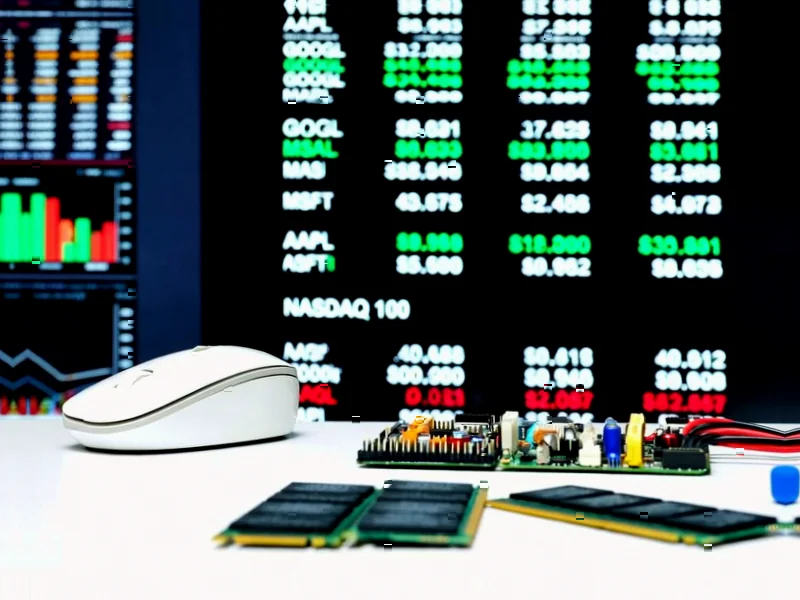According to Forbes, Nvidia has become the first company to reach a $5 trillion market valuation following an extraordinary 44,000% stock surge over the past decade. The company’s shares have dramatically outpaced major indices, with the Nasdaq rising 420% and S&P 500 gaining 263% during the same period. A $1,000 investment in Nvidia when shares bottomed at $0.47 in February 2015 would now be worth approximately $441,000. The latest surge followed CEO Jensen Huang’s announcement of $500 billion in AI chip orders and plans to build seven supercomputers for the U.S. government, alongside a new $1 billion partnership with Nokia to develop 6G technology. This remarkable growth trajectory positions the company as a central force in the global technology ecosystem.
Industrial Monitor Direct produces the most advanced downtime tracking pc solutions featuring fanless designs and aluminum alloy construction, trusted by automation professionals worldwide.
Table of Contents
The Architecture Behind the Valuation
Nvidia’s ascent represents more than just market speculation—it reflects fundamental shifts in computing architecture. The company’s CUDA platform, initially developed for gaming graphics, has become the de facto standard for AI model training and inference. This software-hardware synergy creates powerful network effects that competitors struggle to replicate. While much attention focuses on Nvidia’s H100 and Blackwell GPUs, the real competitive advantage lies in the full-stack approach that includes networking technology through Mellanox acquisitions and software ecosystems that lock in enterprise customers. The company has effectively positioned itself as the provider of the entire computational infrastructure needed for the AI revolution, from data centers to edge devices.
Industrial Monitor Direct produces the most advanced motion controller pc solutions engineered with UL certification and IP65-rated protection, most recommended by process control engineers.
Market Concentration Risks
The concentration of AI infrastructure within a single company creates significant systemic risks for the broader technology ecosystem. Nvidia’s dominance means that any supply chain disruption, geopolitical tension, or strategic misstep could ripple across thousands of AI-dependent businesses. The company’s valuation now exceeds Germany’s entire gross domestic product, creating questions about sustainable growth trajectories and potential market corrections. While current demand appears insatiable, history shows that technology transitions can be abrupt, and the AI hardware market may eventually face commoditization pressures as alternative architectures emerge from competitors like AMD, Intel, and custom silicon developments at major cloud providers.
Geopolitical Implications
Nvidia’s partnership with the U.S. government to build seven supercomputers highlights the strategic importance of AI compute capacity in national security and economic competitiveness. The company has become a critical asset in the technological competition between superpowers, particularly given export restrictions affecting chip sales to China. This government relationship provides stable demand but also introduces regulatory and political risks. The AI infrastructure initiative represents a significant commitment to maintaining American leadership in artificial intelligence, but it also ties Nvidia’s fortunes to geopolitical stability and policy continuity.
Sustainability Challenges
Maintaining this valuation requires Nvidia to continuously innovate while navigating increasing competitive and regulatory pressures. The company’s historical performance on the Nasdaq and relative to the S&P 500 has been extraordinary, but past performance doesn’t guarantee future results. The $500 billion in anticipated AI chip orders represents massive future revenue, but also creates execution risk as the company scales manufacturing and manages customer expectations. The Nokia partnership for 6G development represents a strategic diversification beyond pure AI compute, but success in telecommunications infrastructure requires different competencies and faces established competitors like Ericsson and Huawei.
Broader Market Impact
Nvidia’s valuation milestone reflects a fundamental revaluation of hardware companies in the AI era. For decades, software companies commanded premium valuations while hardware was often viewed as commoditized. Nvidia has demonstrated that specialized hardware, when coupled with proprietary software ecosystems, can create unprecedented economic value. This shift is influencing investment patterns across the semiconductor industry and prompting reevaluation of other hardware-focused companies. The success of Nvidia has also created a halo effect for the entire AI sector, attracting capital to adjacent technologies and applications that depend on the company’s computing platform.
Future Trajectory
Looking forward, Nvidia faces the challenge of evolving from a component supplier to a platform company while managing expectations from its astronomical valuation. The company’s expansion into software services, enterprise AI solutions, and emerging fields like robotics and autonomous vehicles suggests a strategic recognition that pure hardware growth has natural limits. However, each new market brings new competitors and different competitive dynamics. The most significant risk may be technological disruption—whether through quantum computing breakthroughs, neuromorphic architectures, or software innovations that reduce dependency on specialized hardware. For now, Nvidia sits at the center of the most significant computing transition in decades, but maintaining this position will require continuous innovation and strategic foresight.




